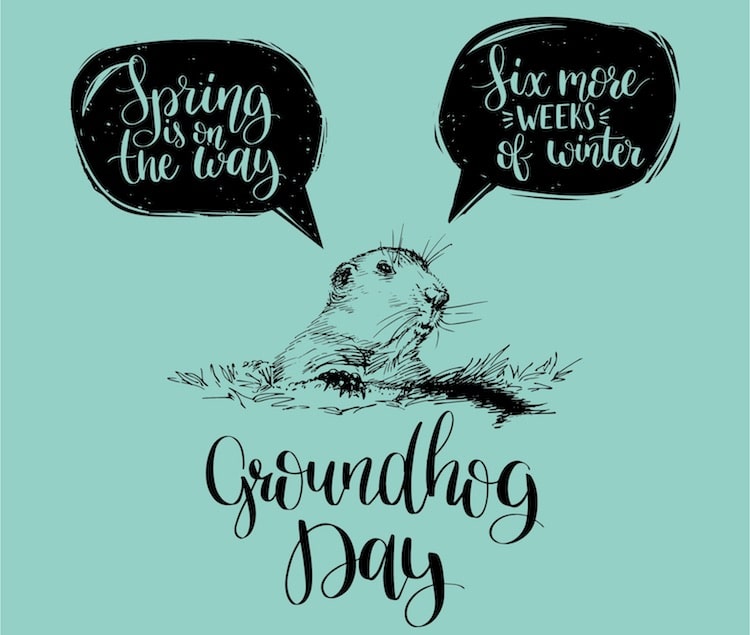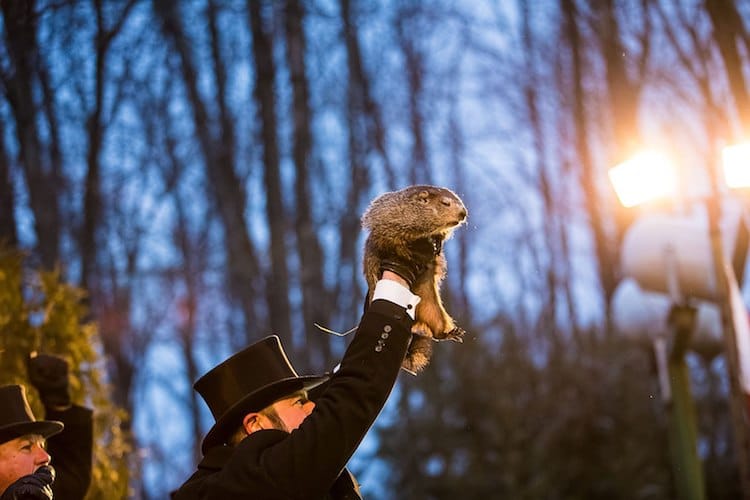
Photo: Stock Photos from Vlada Young/Shutterstock
This post may contain affiliate links. If you make a purchase, My Modern Met may earn an affiliate commission. Please read our disclosure for more info.
Every February, people in Punxsutawney, Pennsylvania brave the cold to catch a glimpse of one very special groundhog. Known as Punxsutawney Phil, this tiny resident is much more than a rodent; in fact, he’s an international celebrity, attracting tens of thousands of bundled-up visitors to his burrow every year.
What makes this woodchuck so popular? According to local legend, Phil can foresee six weeks’ worth of weather, determining whether there will be a long winter or an early spring. Unlike most meteorologists, however, this “furry forecaster” doesn’t need satellites, surface maps, or other fancy technologies to make his predictions; all he relies on is his own shadow—or lack thereof.
Want to dig a bit deeper into this peculiar tradition? Read on to learn all about Groundhog Day.
What is Groundhog Day?

Photo: Stock Photos from Mark Van Scyoc/Shutterstock
Groundhog Day is a tradition that takes place every year on February 2. Prompted by members of the Punxsutawney Groundhog Club—who dress up in top hats and tuxedos for the ceremony—Punxsutawney Phil emerges from a special burrow in Gobbler’s Knob, a rural park nestled just outside of the small town of Punxsutawney. According to superstition, if the sleepy critter casts a shadow (i.e. if it’s a sunny day and the sky is clear), there will be six more weeks of wintry weather. If, on the other hand, the groundhog’s shadow is not visible due to the overcast, there will be an early spring.
The Holiday’s History

Photo: Wikimedia Commons (CC BY-SA 4.0)
Today, Groundhog Day may seem specific to the United States. However, its story has European origins, as it emerged in Pennsylvania’s German communities in the middle of the 19th century. James L. Morris, a Welsh shopkeeper, first mentioned the tradition in a diary entry dated February 2, 1840: “Today the Germans say the groundhog comes out of his winter quarters,” he wrote, “and if he sees his shadow he returns and remains there for 40 days.”
Why did Morris’ German neighbors monitor the movements of the groundhog, an animal native only to North America? According to Don Yoder, a specialist in folklore and the author of Groundhog Day, they were simply adapting Candlemas Day, a weather-predicting tradition that emerged in Medieval Europe and prevailed in German-speaking countries. Like Groundhog Day, the German version of Candlemas featured an animal as its oracle. In this case, however, the medium was not a groundhog, but a hedgehog or badger.

Photo: Stock Photos from Vlada Cech/Shutterstock
Though centered around a different creature, Groundhog Day has a lot in common with Candlemas. “The belief was the same as that in Pennsylvania Dutch Groundhog lore,” Yoder says. “If the badger encountered sunshine on Candlemas and therefore saw his shadow, he crawled back into his hole to stay for four more weeks, which would be a continuation of winter weather. In America, the four weeks became six.”
To fulfill this psychic role, Groundhog Day’s founders decided that not just any woodchuck would do; only Punxsutawney Phil has the power to predict.
Punxsutawney Phil

Photo: Stock Photos from Alan Freed/Shutterstock
Punxsutawney Phil made his grand debut in 1887. Since then, the quirky character has put Punxsutawney on the map. In addition to attracting hoards of people to Gobbler’s Knob on February 2, he also welcomes visitors to his home—a cozy terrarium he shares with his mate, Phyllis—in the Punxsutawney Memorial Library the other 364 days of the year.
With a lifespan of just six years in the wild and 14 years in captivity, you may be wondering how many groundhogs have played “Phil” over the years. According to the Punxsutawney Groundhog Club, the answer is one. His amazing age, they claim, is due to a magical potion called the “Elixir of Life,” which they feed Phil every summer so that he can retain both his “longevity and youthful good looks.”
While this may seem far-fetched, remember that Groundhog Day is a holiday founded on the belief that a rodent’s shadow can forecast the weather. So, with this in mind, the idea of a 133-year-old woodchuck may not be so crazy after all!
This article has been edited and updated.
Related Articles:
Valentine’s Day: The Unromantic Origins of This Romantic Holiday
What is Chinese New Year? Unraveling the History of the Enchanting Festival
Día de los Muertos: How Mexico Celebrates Its Annual “Day of the Dead”
The History of Halloween: Exploring the Age-Old Origins of the Enchanting Holiday
